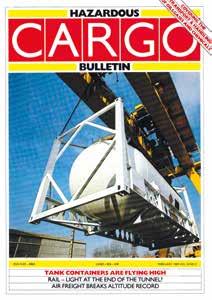
2 minute read
30 Years Ago
A LOOK BACK AT FEBRUARY 1989
As the UK struggles to disentangle itself in an orderly fashion from the EU, it is educational to look back 30 years and take a look at the concerns expressed at the time about closer ties with the mainland. In his editorial, then editor Mike Corkhill looked in particular at the UK’s plans to adopt ADR as the regulatory basis for its domestic road transport.
Mike wrote that, over the preceding decades, “Britain’s timehonoured barriers between itself and Europe have slowly, and often begrudgingly, crumbled”. At the time, though, with the completion of the Channel Tunnel only a few years away, he noted that “transport links have improved a hundredfold”.
Still, the prospect of adopting ADR was daunting. It was seen as a complicated set of regulations and not-user friendly, at least compared to the UK’s well-established regulations. That was, of course, before ADR was thoroughly restructured: it is now one of the most userfriendly sets of rules going.
Mike also raised the question of why the UK had not adopted ADR for domestic transport at some point after 1957, when it was implemented for international transport between the UK and the rest of Europe. Some government departments rejected that on the grounds that it would not properly safeguard the UK public. Fire brigades also felt that Europe’s Kemler placarding system used on tank vehicles was not as good as the UK’s own Hazchem system – although since adopting ADR the UK has managed to continue using Hazchem.
Overall, though, Mike felt that, with the establishment of a free market in the European Economic Community due to be in place in 1992, the concept of purely ‘domestic’ transport was diminishing. As such, while there might be some short-term impact on industry, the UK was right to move over to ADR for domestic transport. “It may be painful – like the loss of shillings and pence – but future shippers and carriers of dangerous goods can only benefit from a harmonised system,” he said.
Transport companies in the UK are currently wondering whether Brexit will deliver painful short-term impacts (or even long-term problems) but there is no suggestion that the UK will stop applying ADR, which perhaps indicates that industry and regulators are both more comfortable with it than they were back in 1989.
Meanwhile, the February 1989 issue reported on the September 1988 joint meeting of RID/ADR experts (there being no ADN in those days). There was a lot of discussion about proposals to revise the provisions for Division 4.1 flammable solids, although reading through our report it is still not clear why some liquids end up in that classification.
It is also instructive to learn that it was only in 1988 that the RID and ADR regulations were beginning to adopt the UN’s system of ‘NOS’ or ‘not otherwise specified’ entries. Up to that point, there were ‘restrictive’ and ‘non-restrictive’ classes and divisions in RID/ ADR: ‘restrictive’ classes covered only substances explicitly specified, while ‘non-restrictive’ classes included any substance meeting the definitions. It was found that, with the revision of the Division 4.1 work, the NOS approach worked much better. However, given the amount of work involved, proposals to do the same for Divisions 4.2 and 4.3 had to be held over for another year.











